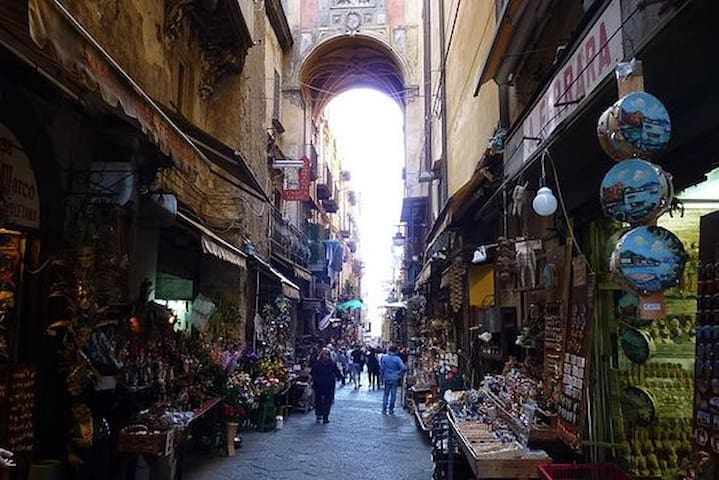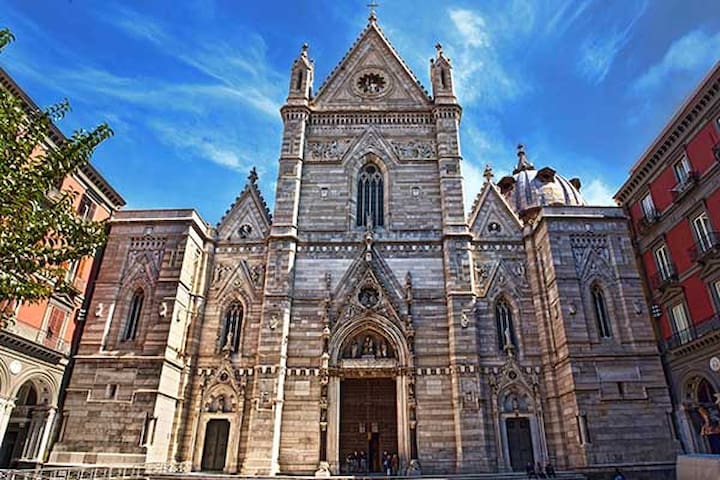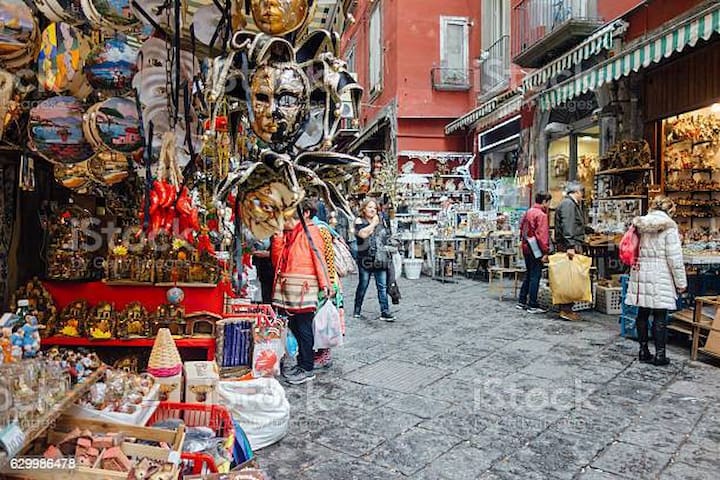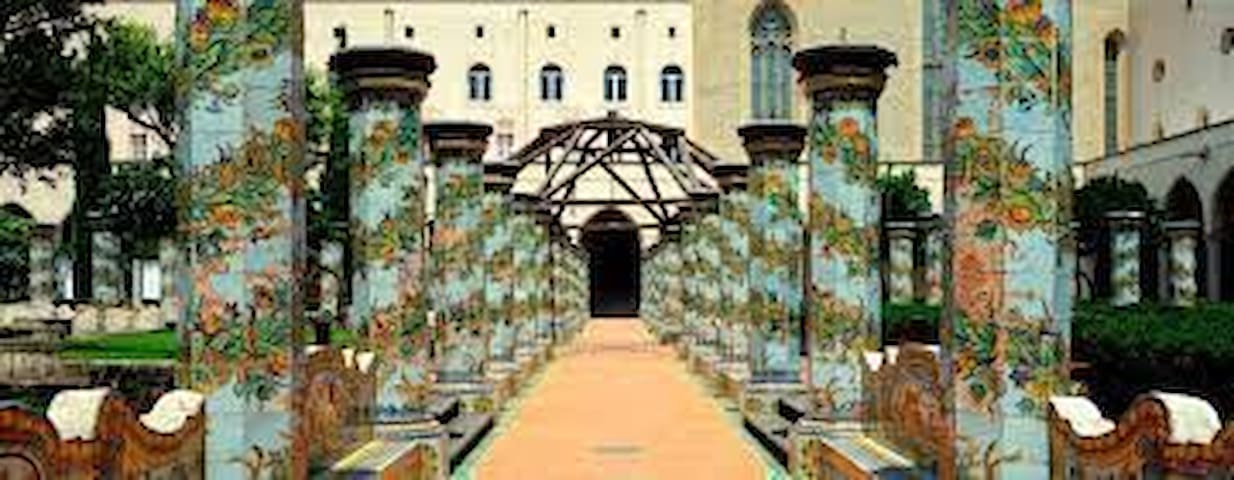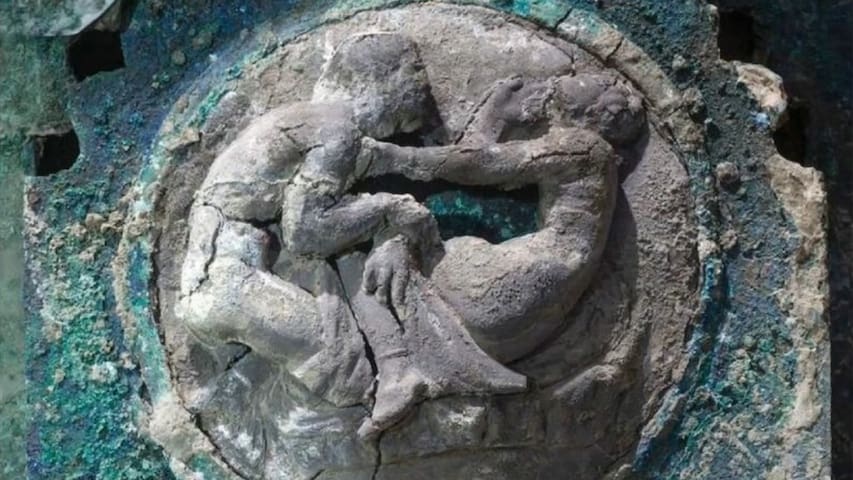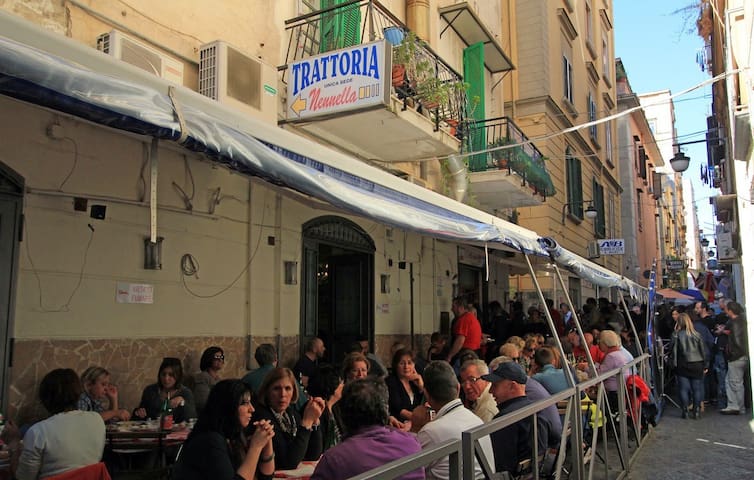Street food and sightseeing
This street is 6 meters wide and runs for 2km. It is the main stretch for tourists and splits the center of the historic old town (centro storico) in half.
The street was one of three Greco-Roman parallel main streets originally called Decumanus inferior.
The street is not only an attraction in itself but is conveniently close to many of the city’s top attractions like Santa Chiara, Santa Maria, San Biagio Maggiore and several of the well known city squares.
Spaccanapoli
Via dei TribunaliThis street is 6 meters wide and runs for 2km. It is the main stretch for tourists and splits the center of the historic old town (centro storico) in half.
The street was one of three Greco-Roman parallel main streets originally called Decumanus inferior.
The street is not only an attraction in itself but is conveniently close to many of the city’s top attractions like Santa Chiara, Santa Maria, San Biagio Maggiore and several of the well known city squares.
Sightseeing
This church holds several valuable works of art. Its most famous piece is The Seven Works of Mercy by Caravaggio which hangs above the high altar. The church is also home to work by Carlo Sellitto, Luca Giordano, Battistello Caracciolo and Fabrizio Santafede.
Church and Quadreria (Picture Gallery) - Full price €7, reduced €5 (students, EU citizens under 18yrs, EU citizens over 65yrs), family ticket €14 (2 adults and up to 3 children under 16yrs)
113 habitants recommandent
Pio Monte della Misericordia
253 Via dei TribunaliThis church holds several valuable works of art. Its most famous piece is The Seven Works of Mercy by Caravaggio which hangs above the high altar. The church is also home to work by Carlo Sellitto, Luca Giordano, Battistello Caracciolo and Fabrizio Santafede.
Church and Quadreria (Picture Gallery) - Full price €7, reduced €5 (students, EU citizens under 18yrs, EU citizens over 65yrs), family ticket €14 (2 adults and up to 3 children under 16yrs)
The Duomo di Santa Maria Assunta or Duomo di San Gennaro is a medieval cathedral established in the 4th century but the baptistery is the only surviving part of the original structure. The present building is in the Gothic-style and was completed in 1323.
313 habitants recommandent
Cathédrale Santa Maria Assunta
147 Via DuomoThe Duomo di Santa Maria Assunta or Duomo di San Gennaro is a medieval cathedral established in the 4th century but the baptistery is the only surviving part of the original structure. The present building is in the Gothic-style and was completed in 1323.
The Girolamini Church was established in the late 16th century and early 17th century. It was named for the followers of San Filippo Neri who bought a former palace which stood on this site and had it demolished and a church built in its place.
€5, reduced price €2.5, free for EU citizens under 18yrs, free first Sunday of every month
29 habitants recommandent
Girolamini
Piazza GerolominiThe Girolamini Church was established in the late 16th century and early 17th century. It was named for the followers of San Filippo Neri who bought a former palace which stood on this site and had it demolished and a church built in its place.
€5, reduced price €2.5, free for EU citizens under 18yrs, free first Sunday of every month
Travel back 2400 years to the heart of where Naples began. The historic site is situated underground beneath the Naples old town. The underground world shows marks and signs from many eras in the history of Naples.
15€, 5€ for children under 5-10
687 habitants recommandent
Napoli Sotterranea
68 Piazza San GaetanoTravel back 2400 years to the heart of where Naples began. The historic site is situated underground beneath the Naples old town. The underground world shows marks and signs from many eras in the history of Naples.
15€, 5€ for children under 5-10
Not to be confused with the church San Gregorio Armeno which gives this street its name. This narrow cobbled alley between Via dei Tribunali and Via San Biagio dei Librai is also known as Christmas Alley. On both sides of the alley are artists ‘workshops and stores producing and selling nativity scenes or presepi. Naples is famed for its presepi scenes and individual figurines and “accessories.”
616 habitants recommandent
Via San Gregorio Armeno
Via San Gregorio ArmenoNot to be confused with the church San Gregorio Armeno which gives this street its name. This narrow cobbled alley between Via dei Tribunali and Via San Biagio dei Librai is also known as Christmas Alley. On both sides of the alley are artists ‘workshops and stores producing and selling nativity scenes or presepi. Naples is famed for its presepi scenes and individual figurines and “accessories.”
This chapel is also called Chapel of Santa Maria della Pieta or Pietatella. It is located in the historic area of Naples and is best known for the many precious works of art by 18th century masters.
The chapel is shrouded in legend. In about 1590 a wrongly convicted man was led to prison passed the garden of the di Sangro Palace. He witnessed part of the wall cave in and an image of the Virgin Mary appear. He vowed to offer a silver lamp and dedication if his innocence was recognized. The man was released and kept his vow. The site where he saw the image of the Madonna became sacred. Not long after than Giovan Francesco di Sangro, Duke of Torremaggiore fell ill and preyed at the sacred site. He was cured and erected a modest chapel at the site in thanks. His son Alessandro di Sangro later built a more elaborate chapel in the 17th century. Only some features of the 17th century structure remains including the polychrome decorated apse. It became the family tomb in 1613 and was later renovated to its present appearance by Prince Raimondo di Sangro. He added several features including Masonic symbols. A secret passage way led to the Sansevero Palace until 1888.
1008 habitants recommandent
Museo Cappella Sansevero
19/21 Via Francesco de SanctisThis chapel is also called Chapel of Santa Maria della Pieta or Pietatella. It is located in the historic area of Naples and is best known for the many precious works of art by 18th century masters.
The chapel is shrouded in legend. In about 1590 a wrongly convicted man was led to prison passed the garden of the di Sangro Palace. He witnessed part of the wall cave in and an image of the Virgin Mary appear. He vowed to offer a silver lamp and dedication if his innocence was recognized. The man was released and kept his vow. The site where he saw the image of the Madonna became sacred. Not long after than Giovan Francesco di Sangro, Duke of Torremaggiore fell ill and preyed at the sacred site. He was cured and erected a modest chapel at the site in thanks. His son Alessandro di Sangro later built a more elaborate chapel in the 17th century. Only some features of the 17th century structure remains including the polychrome decorated apse. It became the family tomb in 1613 and was later renovated to its present appearance by Prince Raimondo di Sangro. He added several features including Masonic symbols. A secret passage way led to the Sansevero Palace until 1888.
This museum is housed in a 17th century house and holds a rich collection of Roman artifacts from Pompeii, Stabiae and Herculaneum as well as an Egyptian collection. The ancient art includes works produced in the Roman era, Greek era and Renaissance era.
796 habitants recommandent
Musée archéologique national de Naples
18 Piazza MuseoThis museum is housed in a 17th century house and holds a rich collection of Roman artifacts from Pompeii, Stabiae and Herculaneum as well as an Egyptian collection. The ancient art includes works produced in the Roman era, Greek era and Renaissance era.
This ornate church (also called Trinità Maggiore) is on a square of the same name. This was the main center for the Jesuit community together with the adjacent buildings. It was constructed by the Jesuits from 1584 to 1601 on the site of the former Palazzo dei Sanseverino. The church’s most striking feature is the small pyramid-shaped ashlar stones which cover the entire façade.
200 habitants recommandent
Gesù Nuovo
2 Piazza del Gesù NuovoThis ornate church (also called Trinità Maggiore) is on a square of the same name. This was the main center for the Jesuit community together with the adjacent buildings. It was constructed by the Jesuits from 1584 to 1601 on the site of the former Palazzo dei Sanseverino. The church’s most striking feature is the small pyramid-shaped ashlar stones which cover the entire façade.
This church is within the Santa Chiara Museum Complex in the Franciscan citadel in the heart of historic Naples. It is one of the city’s largest and most important religious structures. The church was established in 1310 and completed in 1328 by Robert of Anjou for Queen Sancha who later became a nun. The church has a Gothic-style and in the 1700s the interior was redecorated in the baroque-style. The church was destroyed by bombing during WWII and was faithfully reconstructed in its original form.
190 habitants recommandent
Complexe monumental de Santa Chiara
49/c Via Santa ChiaraThis church is within the Santa Chiara Museum Complex in the Franciscan citadel in the heart of historic Naples. It is one of the city’s largest and most important religious structures. The church was established in 1310 and completed in 1328 by Robert of Anjou for Queen Sancha who later became a nun. The church has a Gothic-style and in the 1700s the interior was redecorated in the baroque-style. The church was destroyed by bombing during WWII and was faithfully reconstructed in its original form.
This church is also known as Sant’Anna dei Lombardi, it dates back to 1411 and was named after the order of nuns from Monte Oliveto Abbey who ran the church. The structure of the church underwent changes by Domenico Fontana in 1581 and again in the 17th century when it was redesigned in the baroque style under the direction of Gaetano Sacco. In 1798 the nuns were expelled from the church and convent and the secular Arch-Confraternity of Lombardi moved in changing the name to Sant’Anna dei Lombardi.
Sant'Anna Dei Lombardi station
This church is also known as Sant’Anna dei Lombardi, it dates back to 1411 and was named after the order of nuns from Monte Oliveto Abbey who ran the church. The structure of the church underwent changes by Domenico Fontana in 1581 and again in the 17th century when it was redesigned in the baroque style under the direction of Gaetano Sacco. In 1798 the nuns were expelled from the church and convent and the secular Arch-Confraternity of Lombardi moved in changing the name to Sant’Anna dei Lombardi.
This large medieval New Castle or Maschio Angioino is located opposite the Piazza Municipio and was built in 1279 when the capital of the Kingdom of Naples was Palermo and Naples was the secondary royal residence. Charles I of Naples moved the capital to Naples and had a new castle constructed which was completed in 1279. The historic center of Naples grew up around the castle. In 1347 the castle was expanded and restored through the years suffered attacks several times and then restored. Today the castle houses the Civic Museum.
212 habitants recommandent
Musée Civique de Castel Nuovo
Via Vittorio Emanuele IIIThis large medieval New Castle or Maschio Angioino is located opposite the Piazza Municipio and was built in 1279 when the capital of the Kingdom of Naples was Palermo and Naples was the secondary royal residence. Charles I of Naples moved the capital to Naples and had a new castle constructed which was completed in 1279. The historic center of Naples grew up around the castle. In 1347 the castle was expanded and restored through the years suffered attacks several times and then restored. Today the castle houses the Civic Museum.
The Palazzo Reale was constructed under the Spanish rule of King Phillip III around 1600 and went on to be the residence of Charles III of Spain, Austrians, Bourbons and then the Savoy Kings. The palace was initially designed by Domenico Fontana. The huge palace on Piazza del Plebiscito has 30 rooms which have been turned into a palace museum.
408 habitants recommandent
Palais royal de Naples
1 Piazza del PlebiscitoThe Palazzo Reale was constructed under the Spanish rule of King Phillip III around 1600 and went on to be the residence of Charles III of Spain, Austrians, Bourbons and then the Savoy Kings. The palace was initially designed by Domenico Fontana. The huge palace on Piazza del Plebiscito has 30 rooms which have been turned into a palace museum.
This Naples public square dates back to the 19th century and is named after the plebiscite (referendum) in 1863 which led to Naples joining Unified Italy. The square was planned as a tribute to the Emperor Napoleon by Murat, king of Naples and brother-in-law of Napoleon. Once the Bourbons were restored to the throne the plans for the square continued but not as a homage to the banished Emperor of France. The semi-circular piazza is the site of one of four Royal Palaces in Naples and the San Francisco di Paola church. The church façade was designed to resemble the Roman Pantheon and has a long curved colonnade. In front of the church are two bronze equestrian statues. Canova created the statues of Ferdinand I of Bourbon on horseback and Charles III of Bourbon on horseback. On the façade of the 17th century Royal Palace there are archways separated by eight niches with statues of famous Naples kings. Two other palaces (Palazzo della Prefettura and Palazzo Salerno) complete the semi-circle of buildings. Palazzo della Prefettura is home to the famous Café Gambrinus.
The square is often the venue for large contemporary art instillations as well as annual special events like the New Years Eve fireworks and musical concerts of international celebrities.
464 habitants recommandent
Place du Plébiscite
Piazza del PlebiscitoThis Naples public square dates back to the 19th century and is named after the plebiscite (referendum) in 1863 which led to Naples joining Unified Italy. The square was planned as a tribute to the Emperor Napoleon by Murat, king of Naples and brother-in-law of Napoleon. Once the Bourbons were restored to the throne the plans for the square continued but not as a homage to the banished Emperor of France. The semi-circular piazza is the site of one of four Royal Palaces in Naples and the San Francisco di Paola church. The church façade was designed to resemble the Roman Pantheon and has a long curved colonnade. In front of the church are two bronze equestrian statues. Canova created the statues of Ferdinand I of Bourbon on horseback and Charles III of Bourbon on horseback. On the façade of the 17th century Royal Palace there are archways separated by eight niches with statues of famous Naples kings. Two other palaces (Palazzo della Prefettura and Palazzo Salerno) complete the semi-circle of buildings. Palazzo della Prefettura is home to the famous Café Gambrinus.
The square is often the venue for large contemporary art instillations as well as annual special events like the New Years Eve fireworks and musical concerts of international celebrities.
Mount Vesuvius is best remembered as the volcano which left Pompeii covered in lava when it erupted in 79AD. It is located just a half hour drive from Naples in the Vesuvius National Park and is usually visited as part of a day trip from either Naples or Rome. A day trip to Mt. Vesuvius can be coupled with a visit to Pompeii. The volcano is known to have an eruption cycle of approximately every 20 years, and the earliest known eruption was 25,000 to 17,000 years ago. However the last eruption was in 1944. It is safe to visit but you should know this is a “real” volcano. This is the last active volcano in continental Europe. The volcano reaches 1,282 meters above sea level, has a crater with a diameter of 650 meters and a depth of 230 meters.
Visitors are usually take a bus to the foot of the mount at an altitude of about 1000 meters above sea level. From there it is a hike to reach the highest point on the trail. Visitors should come prepared for the walk which is not difficult but not suitable for those with health issues. Bring along warm clothing, good walking shoes, water, a hat and sunscreen. There are 9 nature trails which wend their way around and up the mountain but most tourists follow trail 5 (The Gran Con or red trail) which starts in the car park in the municipality of Ercolano. Trail 5 will take you to the cone of the crater. The entire length of trail 5 is 3807 meters and you will reach a maximum altitude of 1170 meters above sea level. The climb should take you 2-3 hours there and back. There are routes of 1-5 hours. Once you reach the end of the trail you will have beautiful views out across Naples bay and unforgettable views looking into the crater. While on your way to Vesuvius you will probably go through Ercolano where there is the Museum of the Vesuvius.
92 habitants recommandent
Mount Vesuvius
Mount Vesuvius is best remembered as the volcano which left Pompeii covered in lava when it erupted in 79AD. It is located just a half hour drive from Naples in the Vesuvius National Park and is usually visited as part of a day trip from either Naples or Rome. A day trip to Mt. Vesuvius can be coupled with a visit to Pompeii. The volcano is known to have an eruption cycle of approximately every 20 years, and the earliest known eruption was 25,000 to 17,000 years ago. However the last eruption was in 1944. It is safe to visit but you should know this is a “real” volcano. This is the last active volcano in continental Europe. The volcano reaches 1,282 meters above sea level, has a crater with a diameter of 650 meters and a depth of 230 meters.
Visitors are usually take a bus to the foot of the mount at an altitude of about 1000 meters above sea level. From there it is a hike to reach the highest point on the trail. Visitors should come prepared for the walk which is not difficult but not suitable for those with health issues. Bring along warm clothing, good walking shoes, water, a hat and sunscreen. There are 9 nature trails which wend their way around and up the mountain but most tourists follow trail 5 (The Gran Con or red trail) which starts in the car park in the municipality of Ercolano. Trail 5 will take you to the cone of the crater. The entire length of trail 5 is 3807 meters and you will reach a maximum altitude of 1170 meters above sea level. The climb should take you 2-3 hours there and back. There are routes of 1-5 hours. Once you reach the end of the trail you will have beautiful views out across Naples bay and unforgettable views looking into the crater. While on your way to Vesuvius you will probably go through Ercolano where there is the Museum of the Vesuvius.
A visit to the iconic UNESCO site of Pompeii from Rome or Naples is a must for most travelers. Visitors come to see the archaeological remains (scavi) left of the Roman city which was covered in lava when Mount Vesuvius erupted in 79AD. Pompeii refers to the archaeological park as well as to the town. But it is the archaeological site which interests tourists most and the statue of Madonna in the central square that draws the locals.
Pompeii (and neighboring cities like Herculaneum) was frozen in time when Mt. Vesuvius erupted leaving the city plan, civil buildings, streets, homes, frescoes, walls and nearby rural villas intact. The towns and territory of the commune of Pompeii were covered in 4-6 meters deep of ash and pumice(volcanic rock in its powdered form). There are 5 official archaeological sites in the area.
Pompeii was originally established in the 6th or 7th century BC and became a Roman colony in 80BC. When it was destroyed by the eruption 160 years later there were approximately 11,000 residents. Covered in the ash the city remained hidden for hundreds of years and all that lay beneath the surface was preserved protected from the moisture and air. Human bodies had of course disintegrated and rotted but during the excavations plaster was used to fill in the spaces bodies left beneath the ash layer. This way we can see the actual position and physical activities people were in when the volcano erupted. Visitors should make sure they see the Pompeii forum, the brothel, the villa called House of the Faun, the frescoes and the amphitheatre.
Just 3km north of Pompeii you can visit the Antiquarium di Boscoreale and there are other interesting museums in the area if you plan to make more than a day trip. If you are traveling with an organized tour then you will not have the headache of getting there and back or of booking. However if traveling independently there are certain parts of the site that you need to book in advance to enter. The terme suburbane, Casa del Menandro and Casa degli Amorini Dorati are not open at all hours and must be booked by time slot on the official site arethusa-net
504 habitants recommandent
Pompei
A visit to the iconic UNESCO site of Pompeii from Rome or Naples is a must for most travelers. Visitors come to see the archaeological remains (scavi) left of the Roman city which was covered in lava when Mount Vesuvius erupted in 79AD. Pompeii refers to the archaeological park as well as to the town. But it is the archaeological site which interests tourists most and the statue of Madonna in the central square that draws the locals.
Pompeii (and neighboring cities like Herculaneum) was frozen in time when Mt. Vesuvius erupted leaving the city plan, civil buildings, streets, homes, frescoes, walls and nearby rural villas intact. The towns and territory of the commune of Pompeii were covered in 4-6 meters deep of ash and pumice(volcanic rock in its powdered form). There are 5 official archaeological sites in the area.
Pompeii was originally established in the 6th or 7th century BC and became a Roman colony in 80BC. When it was destroyed by the eruption 160 years later there were approximately 11,000 residents. Covered in the ash the city remained hidden for hundreds of years and all that lay beneath the surface was preserved protected from the moisture and air. Human bodies had of course disintegrated and rotted but during the excavations plaster was used to fill in the spaces bodies left beneath the ash layer. This way we can see the actual position and physical activities people were in when the volcano erupted. Visitors should make sure they see the Pompeii forum, the brothel, the villa called House of the Faun, the frescoes and the amphitheatre.
Just 3km north of Pompeii you can visit the Antiquarium di Boscoreale and there are other interesting museums in the area if you plan to make more than a day trip. If you are traveling with an organized tour then you will not have the headache of getting there and back or of booking. However if traveling independently there are certain parts of the site that you need to book in advance to enter. The terme suburbane, Casa del Menandro and Casa degli Amorini Dorati are not open at all hours and must be booked by time slot on the official site arethusa-net
Food scene
Trattoria da Nennella
22 Vico Lungo Teatro NuovoPizzeria Da Michele
1 Via Cesare SersaleMUST try!
The oldest pizzeria in Napoli.
Starita
27 Via MaterdeiPizzeria Giuliano
33 Calata Trinità MaggiorePintauro
275 Via ToledoDelicious sfogliatella!!
Moccia
21 Via S. PasqualeGran Caffè Gambrinus
1 Via ChiaiaCaffè del professore
n.2 Piazza Trieste e TrentoNeighborhoods
Centro Storico
92 Corso della RepubblicaMergellina
Posillipo

